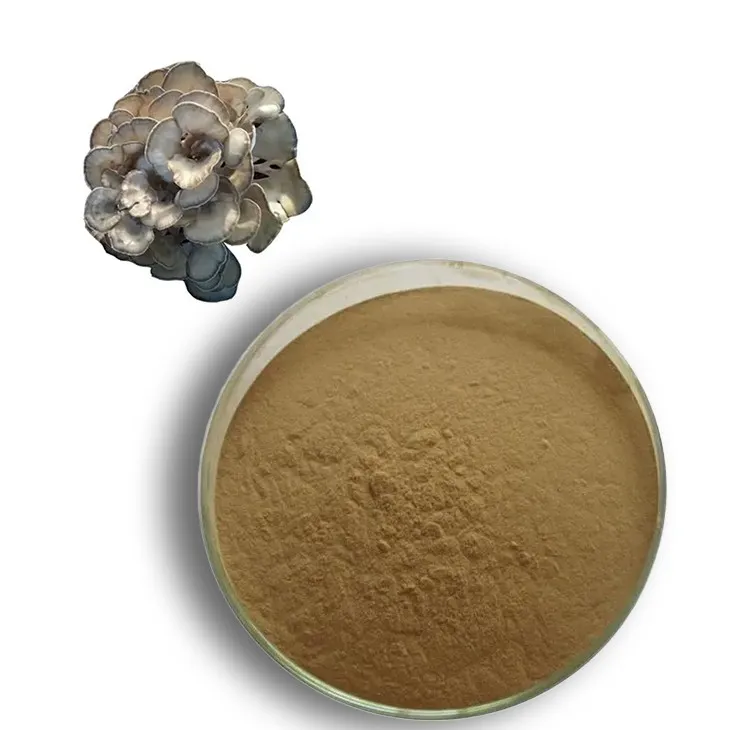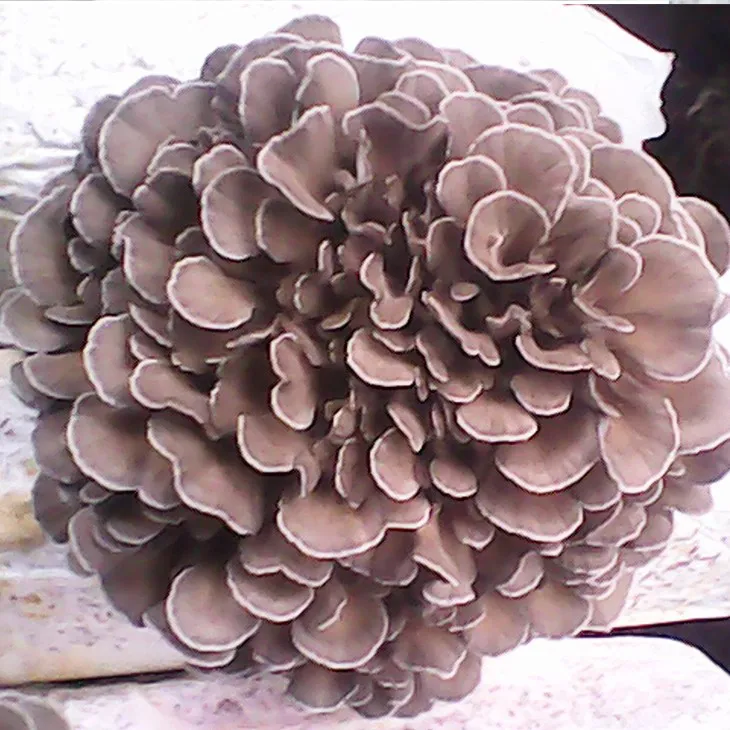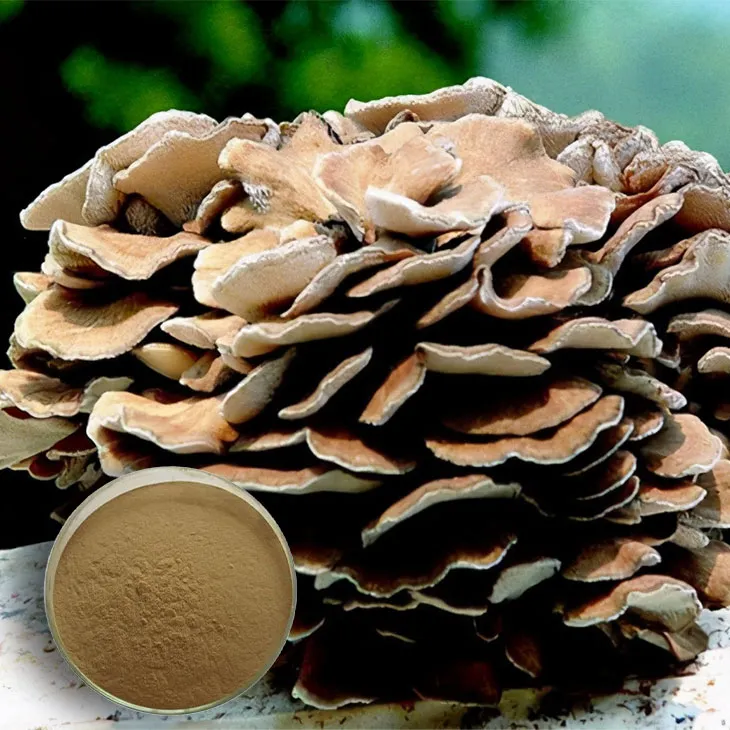- 0086-571-85302990
- sales@greenskybio.com
Extraction Technology and Production Process of Maitake Mushroom Extract.
2024-11-29

1. Introduction
Maitake mushroom, scientifically known as Grifola frondosa, has long been recognized for its potential health benefits. Maitake extract has emerged as an important ingredient in a wide range of health - related products, including dietary supplements, functional foods, and nutraceuticals. Understanding the extraction technology and production process of Maitake extract is crucial for ensuring the quality, efficacy, and safety of these products.

2. Raw Material Selection
The extraction of Maitake extract begins with the careful selection of raw materials. Both fresh and dried Maitake mushrooms can be used as starting materials. However, each has its own advantages and considerations:
2.1 Fresh Maitake Mushrooms
- Advantages: Fresh Maitake mushrooms contain a higher water content, which may contribute to a more efficient extraction process in some cases. They also have a relatively intact cellular structure, which can potentially yield a more complete range of active substances. - Challenges: Handling fresh mushrooms requires more careful storage and processing conditions to prevent spoilage. They are also more perishable, which may limit the time available for extraction.
2.2 Dried Maitake Mushrooms
- Advantages: Dried Maitake mushrooms have a longer shelf - life and are easier to store and transport. The drying process can also concentrate some of the active substances, potentially leading to a more potent extract. - Challenges: The drying process may cause some loss of volatile compounds or heat - sensitive active substances. Rehydration may be required before extraction, which can add an extra step to the process.

3. Extraction Technologies
Several extraction technologies can be used to obtain Maitake extract. One of the most promising methods is microwave - assisted extraction.
3.1 Microwave - Assisted Extraction (MAE)
- Principle: MAE uses microwave energy to accelerate the extraction process. Microwaves generate heat within the Maitake mushrooms by interacting with the polar molecules, such as water. This rapid heating causes the cell walls of the mushrooms to break down more quickly, releasing the active substances, such as polysaccharides, beta - glucans, and other bioactive compounds, into the extraction solvent. - Advantages: - Speed: Compared to traditional extraction methods, such as Soxhlet extraction or maceration, MAE can significantly reduce the extraction time. For example, a Soxhlet extraction may take several hours to days, while MAE can often complete the extraction within minutes to a few hours. - Efficiency: MAE can improve the extraction yield of active substances. The targeted heating of the cell walls allows for a more complete release of the desired compounds, resulting in a higher - quality extract. - Selectivity: By adjusting the microwave parameters, such as power, frequency, and irradiation time, it is possible to selectively extract certain active substances while minimizing the extraction of unwanted components. - Equipment and Procedure: - Equipment: A typical MAE setup consists of a microwave reactor, which is designed to control the microwave power, irradiation time, and temperature. The reactor is usually equipped with a temperature - and pressure - monitoring system to ensure the safety and reproducibility of the extraction process. - Procedure: First, the Maitake mushrooms (either fresh or dried and rehydrated) are placed in a suitable extraction vessel along with the extraction solvent. Common extraction solvents include water, ethanol, or a mixture of both. The vessel is then placed in the microwave reactor, and the extraction parameters are set. After the extraction is complete, the extract is cooled and filtered to remove any solid residues.
3.2 Other Extraction Methods
- Soxhlet Extraction: This is a traditional extraction method that uses a Soxhlet apparatus. The Maitake mushrooms are placed in a thimble, and the extraction solvent is continuously refluxed through the sample. Soxhlet extraction is a time - consuming process but can be useful for obtaining a comprehensive extraction of various compounds. However, it may also extract some unwanted substances, and the high temperature and long extraction time can potentially degrade some heat - sensitive active substances. - Maceration: Maceration involves soaking the Maitake mushrooms in the extraction solvent for an extended period, usually several days to weeks. This method is relatively simple but has a low extraction efficiency and may be more prone to microbial contamination during the long extraction period.

4. Production Process
Once the Maitake extract is obtained through extraction, it undergoes a series of production processes to ensure its quality and suitability for use in various products.
4.1 Testing of Active Ingredient Content
- Importance: After extraction, it is crucial to determine the content of active ingredients in the Maitake extract. For example, the polysaccharide level is an important indicator of the quality and potential health benefits of the extract. Testing allows producers to ensure that the extract meets the required specifications and to monitor the consistency of the production process. - Methods: Various analytical methods can be used to test the active ingredient content. High - performance liquid chromatography (HPLC) can be used to analyze the composition and concentration of specific polysaccharides or other bioactive compounds. Spectroscopic methods, such as ultraviolet - visible (UV - Vis) spectroscopy or infrared (IR) spectroscopy, can also provide information about the chemical structure and functional groups of the extract, which can be related to the presence of active substances.
4.2 Blending and Formulation
- Based on Test Results: Depending on the test results of the active ingredient content, appropriate blending and formulation steps may be carried out. If the extract has a lower - than - expected content of a particular active substance, it may be blended with other batches of extract or supplemented with pure active substances to achieve the desired concentration. - Product Requirements: Blending and formulation also take into account the specific requirements of the final product. For example, if the Maitake extract is intended for use in a dietary supplement in capsule form, the extract may need to be blended with suitable fillers, binders, and other excipients to ensure proper encapsulation and stability.
4.3 Consideration of Cost - Effectiveness
- Optimizing Production Costs: In the production of Maitake extract, cost - effectiveness is an important factor. Producers need to balance the quality of the extract with the cost of production. This can be achieved through various means, such as optimizing the extraction process to reduce the use of expensive solvents or energy, and improving the efficiency of the production line to increase throughput. - Economies of Scale: As the demand for Maitake extract grows, producers can take advantage of economies of scale. By increasing the production volume, they can often reduce the unit cost of production, making the extract more competitive in the market.
5. Quality Control and Assurance
Quality control and assurance play a vital role throughout the extraction technology and production process of Maitake extract.
5.1 Raw Material Quality Control
- Supplier Selection: Producers should carefully select suppliers of Maitake mushrooms to ensure that the raw materials meet the required quality standards. This includes factors such as the origin of the mushrooms, their cultivation methods (e.g., organic or conventional), and any potential contaminants. - Incoming Inspection: Upon receiving the raw materials, a thorough inspection should be carried out. This may include visual inspection for signs of spoilage or damage, as well as laboratory testing for microbial contamination, heavy metals, and pesticide residues.
5.2 Process Control
- Monitoring and Documentation: During the extraction and production processes, key parameters should be continuously monitored and documented. This includes parameters such as extraction temperature, time, solvent composition, and blending ratios. By maintaining accurate records, producers can trace any potential quality issues back to their source and take corrective actions. - Standard Operating Procedures (SOPs): Strict adherence to SOPs is essential for ensuring the consistency and quality of the Maitake extract. SOPs should cover all aspects of the production process, from raw material handling to final product packaging.
5.3 Final Product Quality Assurance
- Release Testing: Before the Maitake extract is released for use in products, final release testing should be carried out. This includes testing for the final active ingredient content, as well as other quality parameters such as purity, solubility, and stability. Only products that meet the established quality criteria should be released. - Batch - to - Batch Consistency: To ensure that the Maitake extract has consistent quality from batch to batch, statistical process control methods can be used. By analyzing data from multiple batches, producers can identify and correct any variations in the production process.
6. Conclusion
The extraction technology and production process of Maitake extract are complex and multi - faceted. By carefully selecting the raw materials, employing advanced extraction technologies such as microwave - assisted extraction, following strict production processes and quality control measures, producers can obtain high - quality Maitake extract. This not only improves the quality of health - related products containing Maitake extract but also enables wider application of this valuable natural ingredient in different markets, meeting the growing demand for natural health products.
FAQ:
What are the main methods for extracting Maitake extract?
Microwave - assisted extraction is a relatively new and effective method. It uses microwave energy to accelerate the extraction process, quickly breaking down the cell walls of Maitake mushrooms and releasing the active substances. Additionally, there may be other traditional extraction methods, but microwave - assisted extraction has shown its advantages in terms of efficiency.
Why is it important to test the active ingredient content after extraction?
Testing the active ingredient content, such as polysaccharide levels, after extraction is crucial. It allows producers to know the quality and potency of the extract. Based on these test results, appropriate blending and formulation steps can be carried out to ensure the consistency of the product. This also helps in meeting the standards and requirements of different health - related products that use Maitake extract.
How does the production process of Maitake extract ensure cost - effectiveness?
The production process takes into account cost - effectiveness in multiple ways. By optimizing the extraction technology, such as using efficient methods like microwave - assisted extraction, it can reduce the time and resources required for extraction. Also, proper management of raw materials (fresh or dried Maitake mushrooms) and streamlining the subsequent testing, blending, and formulation steps can contribute to cost - effective production. This enables producers to offer high - quality Maitake extract at a competitive price in the market.
What are the active substances in Maitake extract?
One of the important active substances in Maitake extract is polysaccharides. These polysaccharides are believed to contribute to the health - related properties of Maitake extract. There may also be other bioactive compounds, but polysaccharides are often a key component that is tested during the production process.
How can the quality of Maitake extract be improved?
The quality of Maitake extract can be improved by optimizing the extraction technology, such as using advanced methods like microwave - assisted extraction. Strictly following standard operating procedures during the production process, including accurate testing of active ingredient content and proper blending and formulation based on the test results, also plays a significant role. Additionally, using high - quality raw materials (fresh or dried Maitake mushrooms) can contribute to the overall quality of the extract.
Related literature
- Optimization of Maitake Mushroom (Grifola frondosa) Extract Production for Enhanced Bioactive Compounds"
- "Recent Advances in Maitake Mushroom Extract: Extraction Techniques and Health Benefits"
- "The Science behind Maitake Mushroom Extract: Production and Quality Control"
- ▶ Hesperidin
- ▶ citrus bioflavonoids
- ▶ plant extract
- ▶ lycopene
- ▶ Diosmin
- ▶ Grape seed extract
- ▶ Sea buckthorn Juice Powder
- ▶ Beetroot powder
- ▶ Hops Extract
- ▶ Artichoke Extract
- ▶ Reishi mushroom extract
- ▶ Astaxanthin
- ▶ Green Tea Extract
- ▶ Curcumin Extract
- ▶ Horse Chestnut Extract
- ▶ Other Problems
- ▶ Boswellia Serrata Extract
- ▶ Resveratrol Extract
- ▶ Marigold Extract
- ▶ Grape Leaf Extract
- ▶ blog3
- ▶ blog4
-
Organic Dandelion Root Extract, Australia.
2024-11-29
-
The best bitter gourd extract in 2024.
2024-11-29
-
The best baicalin in nature.
2024-11-29
-
Chinese lily extract manufacturers.
2024-11-29
-
Nature's best β - carotene.
2024-11-29
-
Standard - process Coenzyme Q10.
2024-11-29
-
Bulk purchase of pomegranate extract.
2024-11-29
-
Cat Claw Extract
2024-11-29
-
Medicinal Marshmallow Extract
2024-11-29
-
Diosmin
2024-11-29
-
Tongkat Ali Extract
2024-11-29
-
Rosemary extract
2024-11-29
-
Scutellaria Extract
2024-11-29
-
Bitter Melon Extract
2024-11-29
-
Beetroot Powder
2024-11-29
-
Cocoa Extract
2024-11-29
-
Black Garlic Extract
2024-11-29





















